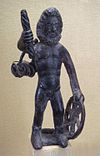- Nehalennia
-
This article is about the goddess Nehalennia. For other uses, see Nehalennia (disambiguation).
 An altar for Nehalennia in Domburg, Netherlands. On her right is a dog, and in her hands a basket of apples.
An altar for Nehalennia in Domburg, Netherlands. On her right is a dog, and in her hands a basket of apples.
Nehalennia (spelled variously) is a (possibly either Germanic or Celtic) goddess attested on and depicted upon numerous votive altars discovered around what is now called the province of Zeeland, the Netherlands, where the Rhine River flowed into the North Sea, whose worship dates back at least to the 2nd century BC, and who flourished in the 2nd and 3rd centuries AD.
Contents
Inscriptions and depictions
Nehalennia is attested on 28 inscriptions discovered in the Dutch town of Domburg, a similar number discovered between 1971 and 1972 in the town of Colijnsplaat, and 2 others from the Cologne-Deutz area of what is now Cologne, Germany.[1]
Nehalennia is almost always depicted with marine symbols and a large, benign-looking dog at her feet.[2][3] Hilda Ellis Davidson describes the votive objects:
Nehalennia, a Germanic goddess worshipped at the point where travellers crossed the North Sea from the Netherlands, is shown on many carved stones holding loaves and apples like a Mother Goddess, sometimes with a prow of a ship beside her, but also frequently with an attendant dog which sits looking up at her (Plate 5). He was on thirteen of the twenty-one altars recorded by Ada Hondius-Crone (1955: 103), who describes him as a kind of greyhound.[4]
Davidson further links the motif of the ship associated with Nehalennia with the Germanic Vanir pair of Freyr and Freyja, as well as the Germanic goddess Nerthus,[5] and draws a connection between the loaves of bread that appear on some depictions Nehalennia with oblong, shin-bone shaped loaves of bread baked in the shape of a boar at the time of Yule in Sweden.[6] Davidson further states that customs in Värmland, Sweden "within living memory" describe grain from the last sheaf being used to bake a loaf into the shape of a little girl, as well as examples of elaborate loaves being used for religious festivals, for fertility of fields in Anglo-Saxon England, and examples from Ireland.[6]
Temples
Religious practices surrounding Nehalennia were at their peak in the 2nd and 3rd centuries AD, at which time there were at least two to possibly three temples located in the area of what is now Zeeland. At the time, this region on the sea coast was an important link for the trade between the Rhine area and Britain. It is known that the tribe of the Morini, who lived in what is now the Netherlands, bordering the North Sea coast, worshipped Nehalennia.[2] Visitors came to worship from as far away as Besançon, France and Trier, Germany.[2] Nehalennia had two sanctuaries or shrines, embellished with numerous altars: one at Domburg on the island of Walcheren, and another at Colijnsplaat on the shore of the Oosterschelde.[2] Both are now submerged beneath the North Sea due to the floods and changing seas in Southern Netherlands.
In August 2005, a replica of the Nehalennia temple near the lost town of Ganuenta was opened in Colijnsplaat.[7]
Modern influence
- Asteroid 2462, or 6578 P-L, is named after the goddess, as is a corona on Venus.[1]
- One of the secondary schools in Middelburg is named after the goddess Nehalennia. One of the original Roman altars is displayed at the school's entrance.
See also
Notes
References
- Davidson, H. R. Ellis (1990). Gods and Myths of Northern Europe. Penguin Books. ISBN 0-14-013627-4.
- Green, Miranda (1992). Symbol and Image in Celtic Religious Art.
- Green, Miranda (1998). Animals in Celtic Life and Myth. London, UK: Routledge.
- Grimm, Jacob (1835). Deutsche Mythologie (German Mythology); From English released version Grimm's Teutonic Mythology (1888); Available online by Northvegr 2004-2007:Chapter 13, page 3. File retrieved 09-24-2007.
- Lendering, Jona, Nehalennia, July 2006. File retrieved 09-24-2007.
- Simek, Rudolf (2007) translated by Angela Hall. Dictionary of Northern Mythology. D.S. Brewer. ISBN 0859915131
- Van der Velde, Koert (August 13, 2005). Zeeuwse godin weer thuis. Trouw (Dutch newspaper).
External links
Celtic mythology series Supra-regional Alaunus • Alisanos • Andarta • Anextiomarus • Artio • Aveta • Belenus • Belisama • Borvo • Brigantia • Camulus • Cernunnos • Cicolluis • Cissonius • Condatis • Damona • Matrona • Dis Pater • Epona • Erecura • Esus • Genii Cucullati • Grannus • Ialonus Contrebis • Lenus • Litavis • Loucetios • Lugus • Maponos • Matres • Mogons • Nantosuelta • Ogmios • Rosmerta • Segomo • Sirona • Sucellus • Suleviae • Taranis • Toutatis • Virotutis • VisuciusBritannia Gallia Aquitania Gallia Belgica Abnoba • Ancamna • Arduinna • Arvernus • Icovellauna • Inciona • Intarabus • Iovantucarus • Ritona • Veraudunus • Vindonnus • Vosegus • XulsigiaeGallia Celtica Gallia Cisalpina Gallia Narbonensis Germania Inferior Gallaecia Germanic peoples Languages Prehistory Roman Iron Age Migration Period Germanic Iron Age · Alamanni · Anglo-Saxons (Angles · Jutes · Saxons) · Burgundians · Dani · Franks · Frisii · Geats · Goths (Visigoths · Ostrogoths · Valagoths · Gothic Wars) · Gotlanders · Lombards · Suebi · Suiones · Vandals · Varangians · Christianization of the Germanic peoples · RomanizationSociety and culture Mead hall · Poetry · Migration Period art · Runes (Runic calendar) · Sippe · Law (Lawspeaker · Thing) · Calendar · King · Names · Numbers · Romano-Germanic cultureReligion Wodanaz · Veleda · Tuisto · Mannus · Paganism (Anglo-Saxon · Continental Germanic mythology · Frankish · Norse) · Christianity (Arianism · Gothic)Dress Warfare Burial practices List of Germanic peoples · Portal:Ancient Germanic cultureCategories:- Germanic deities
- Fertility goddesses
- Sea and river goddesses
Wikimedia Foundation. 2010.



